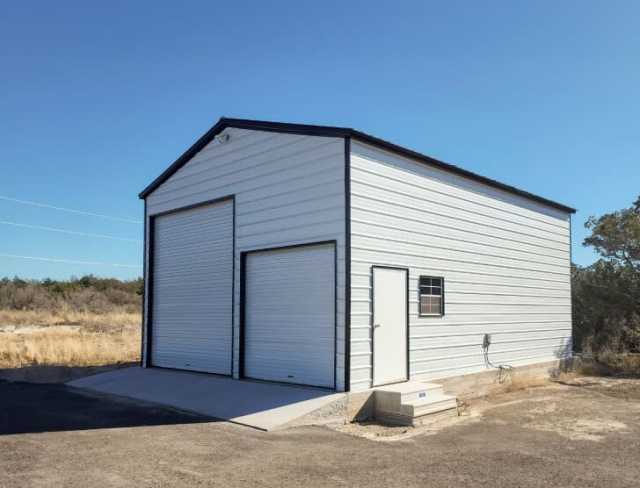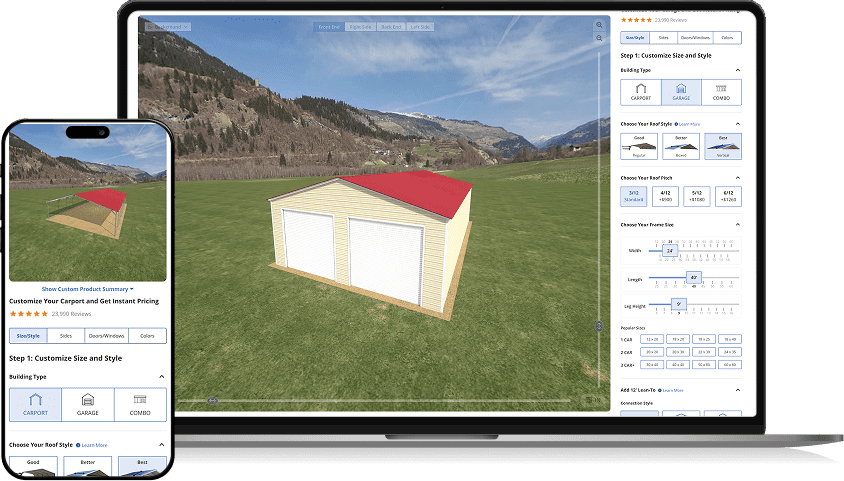If you have not read Chapter 6 on Planning and Pricing Your Foundation already, you may want to start with that to learn what type of foundation is right for you.
Now it’s time to get the site for your future garage ready for installation.
Ground or Gravel Installation
If your garage will be installed directly on the ground or a gravel base, here’s what you need to do:
(Note: These instructions do not apply to a concrete foundation.)
Mark the four corners where your garage will be installed with a flag or a stake.
Make sure the length of each side is correct, and that the diagonal distance between two opposite corners is the same as the distance between the other two opposite corners.
Use a tool called a level to make sure each side is level. If you only have a bubble level, you can also run a string between the corner stakes to help you make sure each side is completely level and that there aren’t any high or low spots.
Make sure that there is enough clear, fairly level space on every side of the garage area, so the installation crew will have space to work.
Take at least one photo from each of the four sides to show that the whole area is clear and level. When you take the photos, be sure to stand far enough back so the whole site is included in each photo.

Concrete Slab
After you order a metal garage, we’ll send you a set of specific recommendations and diagrams for your foundation. Share these recommendations and diagrams with your concrete contractor and get your slab installation scheduled.
The best time to pour concrete is when the weather will be above 50 degrees for a week. If the weather is too cold (below 40 degrees), the concrete can’t set and cure. So if you’re up north and it’s winter, you’ll probably have to wait for warmer weather.
Cure Your Slab
Be sure to ask your contractor for advice on the best way to cure your slab for maximum strength.
Curing is the result of a chemical process called hydration that occurs between the cement and water that are in the concrete mix. As the cement reacts with the water, it forms crystals that bind the aggregates in the concrete together. As this chemical reaction proceeds, the concrete becomes harder and stronger. Usually the concrete will “set” within 24 hours, at which point it is strong enough for a person to walk on without leaving footprints.
After the concrete has set, your slab will continue to harden for years, as long as water is present in the slab for the reaction to continue. However, most of the strengthening will occur in the first few weeks. After a month your slab will have almost reached its full strength.
Keep It Wet. In order for your concrete to reach its full strength, you must prevent too much moisture from escaping from the concrete while it is curing. You should do your best to keep your slab wet for at least one week after it is poured, as long as the outside temperature is above 50 degrees (when it is colder or very humid, there’s no need for more water).
The easiest way to keep your foundation wet is to use a sprinkler with a fine mist setting. Be careful not to spray so much water on your slab that it floods the area around your foundation and compromises its stability.
If the weather is warm enough and you keep the surface moist, the concrete should reach about two-thirds of its full strength within the first week. At this point you can drive on the slab if you need to.
However, you might want to keep your slab wet for a few more weeks so the curing process will continue to strengthen your foundation.
If you don’t think you’ll be able to keep your slab wet for a week or more, your contractor may be able to lay a hassle-free curing blanket, like the UltraCure NCF curing blanket, that will keep your slab moist and warm while it cures. There are many other curing techniques as well, so ask your contractor for his recommendation.
Get Your Garage Installation Scheduled
Once your slab is in place, send us four photos of your site. Take one photo from each side, from a distance, so we can see that the site is ready and that there is at least three feet of fairly level ground on each side for the installation crew (for extra-large garages, plan on six to eight feet or more of space on all four sides). Once we receive these photos and a copy of your permit, your order will be put in a queue for scheduling.
Congratulations! At this point, your garage buying journey is nearly complete—unless you haven’t ordered your garage yet.
If that’s the case, head over to alansfactoryoutlet.com and place your order.
In our next and final chapter, we’ll go over the installation scheduling process and what to expect.




